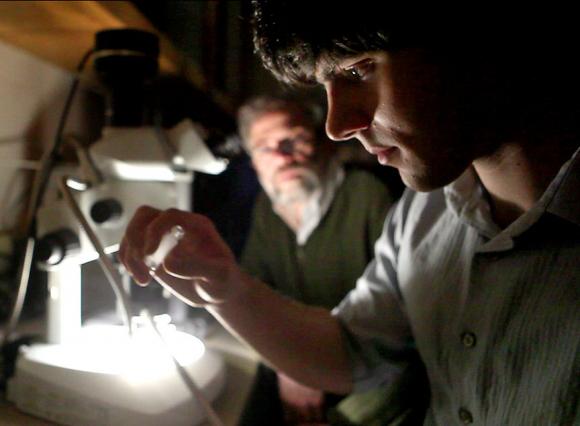How about this for a summer job? “Brown professor seeks enterprising undergraduate to look at soil samples from the moon. Must be a self-starter, independent thinker, with acute attention to detail and an eye for discovery.”
It wasn’t a real job posting, but it describes Thomas Weinreich’s unique assignment in the summer after his freshman year at Brown. And what a payoff: Nearly two years later, Weinreich’s discovery of black specks embedded within lunar crystals is proof that there is water within our planet’s nearest celestial neighbor. The find also landed Weinreich as the second author on a paper in the journal Science, as it challenges existing theories about how the moon formed and how water has made its way to the poles.
“I (still) haven’t wrapped my head around how significant it was going to be,” Weinreich, a junior from Westwood, Mass., said last week as he showed the samples and the microscope he was using to analyze the lunar soils.
That Weinreich got involved at all is serendipitous. Soon after entering Brown, he signed up for first-year seminars, but he didn’t get his first two choices. Casting about for alternatives, he chose a seminar being taught by Alberto Saal, associate professor of geological sciences, titled “Volcanoes: Window into the deep Earth.”
“It ended up being really cool. I really liked the material,” Weinreich said.
His interest caught Saal’s eye and he asked Weinreich to work with him that summer. He was asked to analyze samples of basaltic glass from mid-ocean ridges of the eastern Pacific, one of Saal’s research areas. Impressed with his diligence, Saal gave him the moon assignment.
The work involved peering through a microscope at volcanic glasses, tinged orange, that were returned by astronauts on Apollo 17, the final trip in NASA’s historic moon mission program. The glasses were interesting because eons ago they had cooled moments after they were spat out of the moon’s belly. Saal had taken an interest in the glasses several years ago, as he thought they might preserve volatiles, such as hydrogen and oxygen, which most everyone believed the moon had lost when it was formed in a cataclysmic collision between a proto-Earth and another massive object.
Saal’s hunch had been correct. In 2008, he led a team that showed the moon did harbor water and other volatiles. It was not bone dry after all. But the team still wanted to find out how much water might reside in the moon’s interior, and for that they needed something that would have preserved the gases as they were originally in the lunar mantle.
Weinreich had no idea what he was looking for. He looked at sample after sample of lunar grains, about a thousand in all, when it dawned on him that a precious few he had seen housed clear, olivine crystals with “black dots,” as Weinreich called them. Intrigued, he asked Saal to take a look. Those black dots were lunar melt inclusions, and they housed vestiges of the moon’s mantle that had been encased in crystal before being erupted outward and landing on the surface as colored volcanic glasses. The melt inclusions were the window to the contents of the moon’s interior.
“Tom came one day and said he had found something really different,” Saal said. “When I looked at that, I realized that what Tom had found were the melt inclusions.”
Saal continued, “Then I said to Tom, ‘Do you know what you found? You found something that will be published in Science.’”
Out of thousands of lunar grains that he looked at, Weinreich found just 10 with the enclosed melts. Those were sent to the Carnegie Institution in Washington, where scientists had a special instrument to measure the volatile contents.
From the measurements came a major conclusion: Some parts of the lunar mantle have as much water as the Earth’s upper mantle. That fact may not only upset the prevailing theory about how the moon formed, but it also offers a credible alternative for why water ice is located at the lunar poles. Rather than coming from an outside source, such as a comet, the water may have come from inside the moon, from eruptions long ago.

